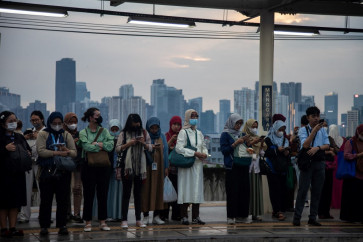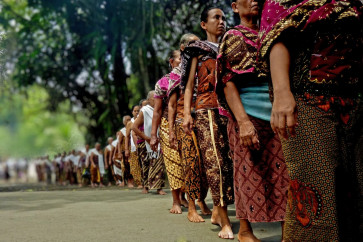Popular Reads
Top Results
Can't find what you're looking for?
View all search resultsPopular Reads
Top Results
Can't find what you're looking for?
View all search resultsUjung Kulon: Memories of paradise
Do not disturb: A bull walks on a grassy field in Cidaon, Ujung Kulon, Banten
Change text size
Gift Premium Articles
to Anyone
D
span class="caption" style="width: 398px;">Do not disturb: A bull walks on a grassy field in Cidaon, Ujung Kulon, Banten. Visitors are advised not to make any noise near the animals.JP/Ricky Yudhistira
It was before sunrise when we arrived by bus in Sumur village, Banten. The six-hour trip from the World Wild Fund for Nature (WWF) office in Jakarta was quite exhausting. The bumpy ride on damaged roads made us forget the prospect of a sound sleep.
The coastal village is the gateway to Ujung Kulon National Park. The sky was gradually brightening, and fishermen were appearing from the sea aboard their boats of various sizes; a number of traders, mostly women, were waiting on the beach.
We were heading for Peucang Island located in Panaitan strait, around three hours sail from Sumur village. But with no terminal, the two ships that were to take us could not berth properly so we used smaller intermediary vessels to board.
“No terminal is built so as to enable locals to share the earnings from ecotourism by hiring out their boats,” said Mirza Sharz from Koperasi Gema Umat (Kagum), a cooperative established to boost the area’s tourist industry.
Kagum was founded in 1999. The local people, comprising mostly of ship and boat owners, caterers, coral transplant farmers and artists are affiliated with this community-based ecotourism management partnership.
Brown water journey: WWF supporters paddle along the Cigenter River. JP/Ricky Yudhistira
The ships we boarded had already been modified to carry tourists, each with a seating capacity of 20 passengers including luggage.
As the vessels were sailing, the sea was fairly calm and the wind not too strong, the weather was moderately warm. These conditions made for favorable sailing, but in no way guaranteed a total exemption from seasickness, however.
We stayed at a resort on Peucang Island. It was a stilted building primarily made of wood. Though
the house was not properly maintained and rather damp, it certainly did not dampen our spirits — the resort stood amid forest trees and a number of wild animals. When we arrived, monkeys, deer, boars and lizards were roaming around the vast yard of the house, while more creatures were playing on the roof.
Blue water beauty: A photographer captures an image of the Indian Ocean on the shores of Tanjung Layar. JP/Ricky Yudhistira
“It’s amazing. I can watch animals at zoos in Europe, but here I can see them directly in their habitat. They’re our hosts and we become their guests,” said Irina Slykova a member of our group from Russia.
She was visiting Ujung Kulon with two friends. It was their first journey to the tropical world. “At the time our choice was either Portugal or Indonesia. We had often toured Europe, so Indonesia seemed more exotic. And now we’re here!” she said.
We spent our time exploring two stunning locations around Peucang Island. In Tanjung Layar there
are the ruins of a Dutch beacon, a colonial look-out, and its supporting building which looked like a
prison. Tanjung Layar is a steep coral slope projecting toward the Indian Ocean and forming the western tip of Java. It’s hard to imagine who was once condemned from afar to this barren jail.
Only 10-minute sail from Peucang Island is the grassland of Cidaon. Bulls and peacocks show up on the plain at around 7 a.m. and 5 p.m.
“You’d better not make any noise or they’ll run away,” said Nazla Mariza from WWF as we were walking about 200 meters from the Cidaon terminal to the grassland. The warning was not fully observed,
but we kept approaching — the closer the better.
The next day we left Peucang Island for Badul Island. It’s a small island with white sand surrounded by clear blue waters. You can walk around its perimeter in only 80 steps.
Queen of the South Seas: Former Miss Indonesia Nadine Chandrawinata (center) and WWF volunteers transplant coral in the seas near Badu Island, Ujung Kulon. JP/Ricky Yudhistira
The island waters are developed to offer beautiful views of underwater scenery, snorkeling and
diving — the ecosystem is maintained through frequent coral transplantation. This was the main reason for our visit to Ujung Kulon.
As soon as coral reefs grow and expand, fish and other marine biota gather there.
We bought corals from Paniis village. Residents have been selling it there for a long time, at around Rp 10,000 per shoot. WWF has recommended that local people, mostly farmers, reproduce coral reefs so as to avoid land reclamation by deforestation, and also to gain extra income.
“When they realized ecotourism turned out to bring profits, they found their sea ecosystem had been damaged, thus prompting them to strive for its conservation,” said Andri Crespo, WWF’s Coastal and Ecotourism officer in Ujung Kulon.
So far the sea waters of Ujung Kulon have been harmed by marine biota hunters in various ways to secure their hauls that sell at high prices on domestic and international markets.
“They come from nearby regions, particularly Jakarta and Lampung,” Mirza said.
We had the opportunity to watch a lesung (rice mortar) dance and martial arts, whilst also learning to carve Java rhino statuettes and make batik from the Taman Jaya villagers. The wood used for the rhino sculptures comes from the waste of housing construction and furniture making, leaving the local forest unscathed.
“Ujung Kulon is complete. Its forest has flora and fauna, its sea has marine biota and its community retains local culture. Sadly, tourism in Indonesia generally has minimum publication. Just compare it with Malaysia, which intensively promotes its tourism in the media in Indonesia,” said Chairil Anwar, a WWF supporter from Cikampek, West Java.
Cruising along Cigenter River by canoe was our last activity before returning to Jakarta. Though unfortunately we didn’t see any pythons hanging from riverside trees, the whole experience reaffirmed those old-forgotten principles of taking nothing but pictures, leaving nothing but footprints and killing nothing but time.
— Photos by JP/Ricky Yudhistira
Ricky Yudhistira visited Ujung Kulon with WWF and was there for three days.













